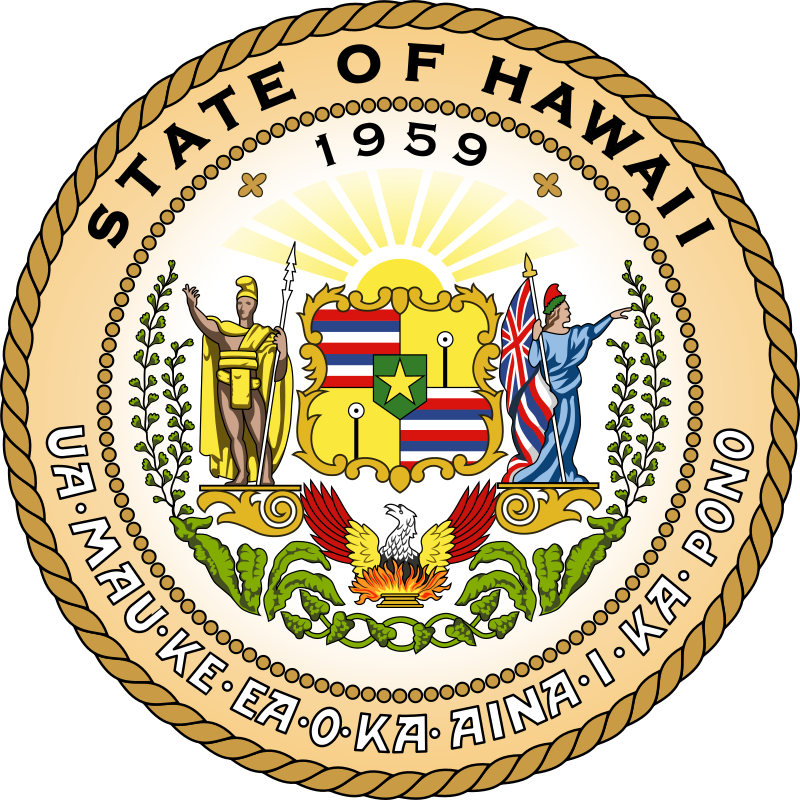
FROM WIKIPEDIA COMMONS
Hawaii (/həˈwaɪ.i/ (listen) hə-WY-ee; Hawaiian: Hawaiʻi [həˈvɐjʔi] or [həˈwɐjʔi]) is a state in the Western United States located in the Pacific Ocean about 2,000 miles (3,200 km) from the U.S. mainland. It is the only state outside North America, the only state composed entirely of islands, and the only state in the tropics. Hawaii is also one of a few U.S. states to have once been an independent nation.
Hawaii comprises nearly the entire Hawaiian archipelago, 137 volcanic islands spanning 1,500 miles (2,400 km) that are physiographically and ethnologically part of the Polynesian subregion of Oceania. The state’s ocean coastline is consequently the fourth longest in the U.S., at about 750 miles (1,210 km). The eight main islands, from northwest to southeast, are Niʻihau, Kauaʻi, Oʻahu, Molokaʻi, Lānaʻi, Kahoʻolawe, Maui, and Hawaiʻi, after which the state is named; it is often called the “Big Island” or “Hawaii Island” to avoid confusion with the state or archipelago. The uninhabited Northwestern Hawaiian Islands make up most of the Papahānaumokuākea Marine National Monument, the nation’s largest protected area and the third largest in the world.
Settled by Polynesians some time between 124 and 1120, Hawaii was home to numerous independent chiefdoms. In 1778, British explorer James Cook was the first known non-Polynesian to arrive at the archipelago; early British influence is reflected in the state flag, which bears a Union Jack. An influx of European and American explorers, traders, and whalers arrived shortly thereafter, introducing diseases that decimated the once isolated indigenous community. Hawaii became a unified, internationally recognized kingdom in 1810, remaining independent until Western businessmen overthrew the monarchy in 1893; this led to annexation by the U.S. in 1898. As a strategically valuable U.S. territory, Hawaii was attacked by Japan on December 7, 1941, which brought it global and historical significance, and contributed to America’s decisive entry into World War II. Hawaii is the most recent state to join the union, on August 21, 1959.[14] In 1993, the U.S. government formally apologized for its role in the overthrow of Hawaii’s government, which spurred the Hawaiian sovereignty movement.
Of the 50 U.S. states, Hawaii is the fourth-smallest in land area and the 11th-least populous, but with 1.4 million residents ranks 13th in population density. Two-thirds of the population lives on O’ahu, home to the state’s capital and largest city, Honolulu. Hawaii is among the country’s most diverse states, owing to its central location in the Pacific and over two centuries of migration. As one of only six majority-minority states, it has the nation’s only Asian American plurality, its largest Buddhist community, and the largest proportion of multiracial people. Consequently, it is a unique melting pot of Southeast Asian, East Asian and North American cultures, in addition to its indigenous Hawaiian heritage.
Historically dominated by a plantation economy, Hawaii remains a major agricultural exporter due to its fertile soil and uniquely tropical climate in the U.S. Its economy has gradually diversified since the mid-20th century, with tourism and military defense becoming the two largest sectors. The state attracts tourists, surfers, and scientists from around the world with its diverse natural scenery, warm tropical climate, abundance of public beaches, oceanic surroundings, active volcanoes, and clear skies on the Big Island. Hawaii hosts the U.S. Pacific Fleet, the world’s largest naval command, as well as 75,000 employees of the Defense Department.
Although its relative isolation results in one of the nation’s highest costs of living, Hawaii is the third-wealthiest state. Honolulu performs well in several world livability indexes, ranking 22nd out of 140 cities worldwide in the 2019 Global Liveability Index, more than any American city.
TODAY’S ALMANAC
1790s
1870s
1880s
1900s
1910s
- 1911: LEONARDO DA VINCI’S MONA LISA WAS STOLEN BY A LOUVRE EMPLOYEE, VINCENZO PERUGGIA
- 1912: ARTHUR R. ELDRED BECAME THE FIRST EAGLE SCOUT, THE HIGHEST RANK IN THE BOY SCOUTS OF AMERICA
1920s
1930s
- BORN 1930: PRINCESS MARGARET (YOUNGER SISTER OF QUEEN ELIZABETH II)
- BORN 1936: WILT CHAMBERLAIN (BASKETBALL PLAYER)
- BORN 1938: KENNY ROGERS (SINGER)
- BORN 1939: CLARENCE WILLIAMS, III (ACTOR)
1940s
1950s
- 1950: UNITED NATIONS BUILDING OPENED IN NEW YORK CITY
- 1955: FAMILY CLAIMED HOME INVADED BY GOBLIN-LIKE SPACE CREATURES, KELLY, KY
- BORN 1956: KIM CATTRALL (ACTRESS)
- 1959: HAWAII BECAME THE U.S.’S FIFTIETH STATE
- BORN 1959: JIM MCMAHON (FOOTBALL PLAYER)
- 1959: EXECUTIVE ORDER FOR A 50-STAR U.S. FLAG ISSUED
1960s
- 1965: GEMINI 5 WAS LAUNCHED AND WENT ON TO BREAK A RECORD, SPENDING EIGHT DAYS IN SPACE
- BORN 1967: CARRIE-ANNE MOSS (ACTRESS)
1970s
- 1976: FOUR MEN POSSIBLY ABDUCTED BY UFO, ALLAGASH WATERWAY, MAINE
- DIED 1978: CHARLES EAMES (DESIGNER & ARCHITECT)
1980s
2010s
- 2012: THE YOUNG AND THE RESTLESS SHOT ITS 10,000TH EPISODE
- 2017: WHAT WAS THE GREAT AMERICAN ECLIPSE?
COURTESY www.almanac.com
